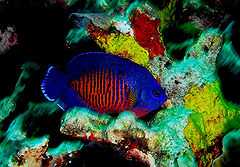Centropyge
| Centropyge | |
|---|---|
 | |
| Twospined angelfish, Centropyge bispinosa | |
| Scientific classification | |
| Kingdom: | Animalia |
| Phylum: | Chordata |
| Class: | Actinopterygii |
| Order: | Perciformes |
| Family: | Pomacanthidae |
| Genus: | Centropyge Kaup, 1860 |
| Species | |
|
See text | |
Centropyge (common name: dwarf angelfish) is a genus of marine angelfishes. The genus is the largest within the Pomacanthid family, comprising over 30 described species.[1] Species in this group do not exceed 15 cm (approximately six inches) in length and live in haremic structures with one dominant male and multiple females. Although it is hard to identify their gender; females are often shorter and more round finned (which is more obvious when looking at a group of specimens).[2] Like many other reef fish and all marine angelfish, species in this genus are protogynous hermaphrodites, meaning that they start their adult lives as females and the dominant individual in a group can change to a male within days. A reversal of this sex change is possible if the social status of the individual changes, it is however a process that requires much more time (weeks to months).[3]
In aquaria
Centropyge prefer matured reef tanks due to the usually high water quality and the often used "live rock". In nature most Centropyge sp. feed on algae, sponges and small benthic invertebrates. Having an abundance of well cured live rock will help to supplement their diet.[4] This is also in the interest of the aquarist, as underfed Centropyge angels may nip at corals and sessile invertebrates.[5] The difficulty of keeping varies from species to species, as does their rarity and correspondingly their price. Centropyge are social species that live in loose groups in the wild. So if multiple Centropyge are kept to a tank, they will establish a pecking order. To reduce the stresses of establishing the dominance in the group it is wise to choose semi-adult specimens or specimens of different size. Aggression levels differ considerably between species, which should be taken into account when trying to house more than one species per tank (adapting the stocking list and order of addition to the tank). Dwarf angels can be quite shy initially, hiding in corals, caves and crevices but become more outgoing when they have established their territory - if they are kept with appropriate tank mates and in appropriately sized tanks.[6]
Species
- Abes Angelfish, Centropyge abei Allen, Young & Colin, 2006.
- Cherubfish, Centropyge argi Woods & Kanazawa, 1951.
- Golden angelfish, Centropyge aurantia Randall & Wass, 1974.
- Flameback angelfish, Centropyge aurantonotus Burgess, 1974.
- Bicolor angelfish, Centropyge bicolor (Bloch, 1787).
- Twospined angelfish or coral beauty angelfish, Centropyge bispinosa (Günther, 1860).
- Peppermint angelfish, Centropyge boylei Pyle & Randall, 1992.
- Cocos-Keeling angelfish, Centropyge colini Smith-Vaniz & Randall, 1974.
- Blue Mauritius angelfish, Centropyge debelius Pyle, 1990.
- blue velvet angelfish, Centropyge deborae Shen et al., 2012.
- Blacktail angelfish, or Eibli angelfish, Centropyge eibli Klausewitz, 1963.
- Rusty angelfish, Centropyge ferrugata Randall & Burgess, 1972.
- Fisher's angelfish, Centropyge fisheri (Snyder, 1904).
- Yellowfin angelfish, Centropyge flavipectoralis Randall & Klausewitz, 1977.
- Lemonpeel angelfish, Centropyge flavissima (Cuvier, 1831).
- Yellow angelfish, or Herald's angelfish, Centropyge heraldi Woods & Schultz, 1953.
- Blackear angelfish, Centropyge hotumatua Randall & Caldwell, 1973.
- Japanese Pygmy angelfish, Centropyge interruptus (Tanaka, 1918).
- Yellowhead angelfish, or Joculator angelfish, Centropyge joculator Smith-Vaniz & Randall, 1974.
- Flame angelfish, Centropyge loricula (Günther, 1874).
 Flame angel, Centropyge loricula
Flame angel, Centropyge loricula - Multicolor angelfish, Centropyge multicolor Randall & Wass, 1974.
- Barred angelfish, Centropyge multifasciata (Smith & Radcliffe, 1911).[4]
- Dusky angelfish, Centropyge multispinis (Playfair, 1867).
- Nahacky's angelfish, Centropyge nahackyi Kosaki, 1989.
- Narcosis angelfish, Centropyge narcosis Pyle & Randall, 1993.
- Blackspot angelfish, Centropyge nigriocella Woods & Schultz, 1953.
- Midnight angelfish, Centropyge nox (Bleeker, 1853).
- Potter's angelfish or Russet angelfish, Centropyge potteri (Jordan & Metz, 1912).
- Resplendent angelfish, Centropyge resplendens Lubbock & Sankey, 1975.
- Mango angelfish, or Shepard's angelfish, Centropyge shepardi Randall & Yasuda, 1979.
- Keyhole angelfish, Centropyge tibicen (Cuvier, 1831).
- Purple masked angelfish, Centropyge venustus (Yasuda & Tominaga, 1969).
- Pearlscale angelfish, or Half-Black angelfish, Centropyge vrolikii (Bleeker, 1853).
In synonymy[7]
- Orangeback angelfish, Centropyge acanthops (Norman, 1922) [=fisheri]
- Whitetail angelfish, Centropyge flavicauda Fraser-Brunner, 1933 [=fisheri]
References
- ↑ Centropyge.net
- ↑ practicalfishkeeping.co.uk
- ↑ Sex changing from male to female on the way of protogynous process in three Centropyge angelfishes (Pomacanthidae: Teleostei). Bull Inst Oceanic Res & Develop, Tokai Univ 17:27–34.
- ↑ 4.0 4.1 http://www.wetwebmedia.com/ca/volume_6/volume_6_2/multifasciata.htm
- ↑ Saltaquarium.about.com
- ↑ http://www.wetwebmedia.com/marine/fishes/angels/centropyge/index.htm
- ↑ Schindler, I.; Schneidewind, F. 2004: Revision of Centropyge fisheri (Snyder, 1904) (Teleostei, Pomacanthidae). Zeitschrift für Fischkunde, 7(1): 31-42. PDF
External links
 Data related to Centropyge at Wikispecies
Data related to Centropyge at Wikispecies- Froese, Rainer, and Daniel Pauly, eds. (2006). Species of Centropyge in FishBase. January 2006 version.
- http://fishlibrary.org